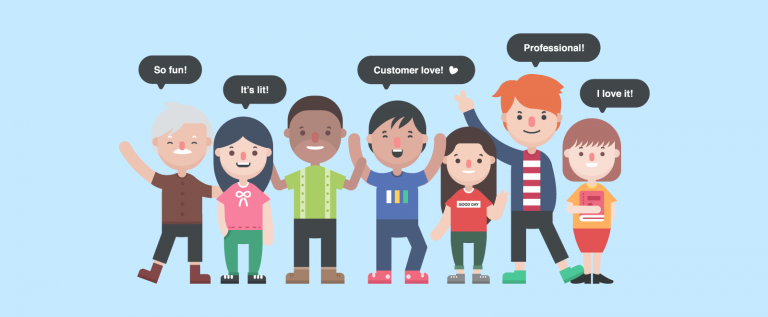Presentation is everything.
For instance, one study concluded that diners were willing to spend as much as three times more on a well-plated dish.
When it comes to brand identity, your visuals are your brand’s first impression.
Logo shapes, colors, and typography can tell your brand story without saying a word, including your company’s purpose and vision.
Not only do these elements capture customers’ attention, but they also cultivate brand recognition. In fact, color alone improves a brand’s recognition by 80 percent.
A 6-step guide to unlocking the power of the crowd for a strong visual brand identity
With social media at the forefront of many marketing strategies, visuals have become the foundation of branding and marketing.
Forward-looking brands understand the need to invest in both time and research into shaping their visual identity.
A powerful resource in the exploration of a visual brand identity is crowdsourcing.
Crowdsourcing enables brands to pool ideas from a diverse group of thinkers and creatives.
Leveraging creative thinkers from various backgrounds will provide a new set of perspectives and valuable feedback.
As these communities often include talent outside of your industry, you’ll earn feedback and insights that you may not hear of before.
This can also strengthen your visual identity and differentiate yourself from competitors.
You can take advantage of these benefits by getting started with your crowdsourcing. Here’s how to do it and what yours should include.
Step 1: Create a project brief.
The first step in tapping the ideas of the crowd is to provide an outline specifying what needs to be done.
Without clearly defined goals and details of your project, you’ll find it harder to achieve a desirable visual identity.
These ideas and objectives can be broken down into what is called a project brief.
A project brief sets clear expectations for the community and empowers them with the steps and information that they need to succeed.
Briefs can include but are not limited to project goals, timelines, deliverables, objectives, and examples (see step 2).
Don’t forget to include your brand tone, which is how your brand will be conveyed through visuals.
Tone can be anything from playful to modern to intriguing.
Armed with an engaging, comprehensive project brief, you will draw in submissions and feedback that will better match your company’s needs and effectively guide your project to completion.
Step 2: Research and provide examples.
After defining your goals through the project brief, the next step is to provide guidance on branding examples or even mockups if you’re looking for feedback.
There are millions of logos, colors, fonts, shapes, themes, photography, and art to sift through. It’s easy to become overwhelmed.
Start by identifying the brands that resonate with you and define what element they carry that makes them appealing. This will help you and the crowd better understand what you want for your brand. In addition, create Pinterest boards and save images to Instagram to archive inspiration.
If you’re still stuck, brainstorming can provide the boost needed to get creative juices flowing. Don’t be afraid to ask the crowd for ideas. The feedback will add to your vision and incorporate concepts you wouldn’t have found on your own.
Step 3: Kick-off crowdsource campaign.
If given a thorough project brief, you can expect fresh perspectives and breakthrough insight at this point.
In this part of the process, you’ll typically begin with quantity and narrow down the list in terms of quality.
With a high volume of visual ideas generated through outsourcing, you must sort and organize.

Involve your team members (if possible) and gather a shortlist of submissions that stand out.
If you are leveraging your team, be sure that votes and reasoning are written down first before sharing it to everyone to mitigate “groupthink”.
Try to consolidate ideas and concepts that are very similar. Once you proceed with audience testing (see 5), visuals that look alike won’t corrupt your results.
Step 4: Offer encouraging feedback.
As ideas from the crowd roll in, provide ongoing feedback to participants, so they’ll know if they need to shift creative direction.
It’s worth noting that feedback should always invoke inspiration and not fear.
While you should always remain transparent, it’s important to provide feedback that is both constructive and encouraging.
Be sure to avoid vagueness and offer specific examples of what you liked and disliked about the submission.
Tiptoeing around your assessments will only lead your crowd in a false direction.
Also, be sure to leave enough time for your creatives to ask question. There could be an aspect of the visuals you didn’t consider, but you can only discover this if you take the time to listen.
Step 5: Audience test.
After crowdsourcing ideas for visuals and narrowing down your list to your top picks, you’ll need to audience test.
Why?
Audience testing is necessary for seeing past our own biases and leanings.
According to Timothy Wilson, professor of psychology at the University of Virginia, we’re unconsciously processing around 11 million pieces of information at any given moment. This means we’re making unconscious decisions at a very rapid rate. Sometimes, we’re blinded by our own unconscious bias.
By seeking an outside perspective, you’re able to discover what visuals will perform well (or not so well) within your market.
If you’ve identified your target audience, try to pull an audience that closely resembles that ideal customer.
You can collect responses using your peer network. Run surveys through relevant forums, Facebook groups, and audience testing services to obtain relevant opinions on your visuals.
Step 6: Analyze results.
Lastly, you’ll want to analyze and evaluate the results of your audience testing.
Keep in mind that the results don’t have to seal the fate of your visual brand strategy.
Audience testing gives you an idea of what may or may not work. You may be completely surprised by the feedback and even receive a reality check.
The results do not have to line up precisely with your end decision. The goal of audience testing is to help you make informed choices and back up your visuals of choice with the power of data.
Crowsourcing may be the missing piece to your visual branding puzzle
Whether your launching a new brand or doing a complete rebranding, visuals are key to standing out.
It’s worth noting that branding goes beyond logos and fonts. Your brand also includes your mission statement through its name, look, and voice.
Harnessing the power of a large creative community is an effective way to guide you through the process of establishing a truly unique and viable visual identity, whether you’re a Fortune 500 company looking for a brand refresh or a small business who wants to dip their toes on visual storytelling.
Although curating visuals can be a daunting process, crowdsourcing may be the missing piece in your strategy.
Editor’s note: This guest post comes from Grant Polachek of Squadhelp.com.
About the Author
Grant Polachek is the Head of Branding at Inc 500 company Squadhelp.com, the worlds #1 naming platform, with 25,000+ customers from early-stage startups across the globe to the largest corporations including Nestle, Philips, Hilton, Pepsi, and AutoNation. Get inspired by exploring these winning business name ideas.



